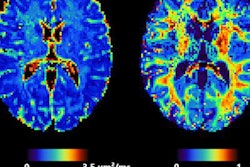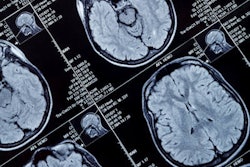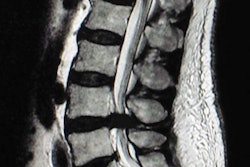
Large white-matter hyperintensity volume identified on brain MRI in people with Alzheimer's disease is strongly associated with poor cognitive function, according to a study published on 28 July in Alzheimer's & Dementia.
Specifically, high white-matter hyperintensity volume in the splenium of the corpus callosum appears to be a particular manifestation of Alzheimer's disease, wrote a team led by Dr. Antoine Garnier-Crussard of Normandy University's Blood and Brain Institute in Caen, France.
"Our findings in a group of [beta amyloid-positive] Alzheimer's disease patients compared to [beta amyloid-negative] controls matched for the main vascular risk factors highlight the clinical relevance of posterior white-matter hyperintensities, and particularly [those] in the splenium of the corpus callosum," the group wrote. "Splenium of the corpus callosum white-matter hyperintensities are the most strongly associated with cognitive performance in Alzheimer's disease, independently from [beta-amyloid] burden and gray-matter loss."
Hyperintense
White-matter hyperintensities are identified on brain MRI as a "hyperintense signal on T2-weighted and fluid-attenuated inversion recovery images," and they are common in older adults who are not yet cognitively impaired, the group wrote -- although they are associated with risk factors such as hypertension and worse cognitive performance in executive function and processing speed.
In patients with Alzheimer's disease, the volume of white-matter hyperintensities tends to be larger than it is in healthy older people. But the authors noted that there is a lack of research exploring the connection between white-matter hyperintensities and cognition in Alzheimer's disease patients.
"The question remains as to if and how the amount and topography of white-matter hyperintensities in Alzheimer's disease differ from age-related white-matter hyperintensities, and whether [they] have region-specific effects on cognition in [beta amyloid-positive] Alzheimer's disease patients," they wrote.
Garnier-Crussard and colleagues conducted a study that included 54 beta amyloid-positive Alzheimer's disease patients identified from memory clinics and 40 beta amyloid-negative controls paired for vascular risk factors (for a total of 94 study participants). Of the beta amyloid-positive patients, 21 had dementia and 33 had mild cognitive impairment. The team used MRI to evaluate each person's regional white-matter hyperintensity volume, controlling for factors such as cerebral amyloid burden, global cortical atrophy, and hippocampal atrophy.
The investigators found that white-matter hyperintensity volume was larger in the amyloid-positive patients than in the healthy controls in all brain regions; in the corpus callosum, the most significant changes were in the splenium. Both higher white-matter hyperintensity volume and these changes in the splenium of the corpus callosum were associated with decreased cognition, the team noted.
| White-matter hyperintensity volume (cm3) in beta amyloid-negative and beta amyloid-positive patients by brain region | ||
| Region | Beta-amyloid negative | Beta-amyloid positive |
| Total | 5.91 | 13.08 |
| Periventricular | 4.25 | 8.28 |
| Deep | 1.54 | 4.63 |
| Frontal | 2.18 | 4.29 |
| Parietal | 1.56 | 4.12 |
| Corpus callosum: Overall | 0.77 | 1.66 |
| Temporal | 0.69 | 1.60 |
| Occipital | 0.66 | 1.44 |
| Corpus callosum: Body | 0.32 | 0.69 |
| Corpus callosum: Splenium | 0.22 | 0.58 |
| Corpus callosum: Genu | 0.23 | 0.39 |
"Regarding the relationships with cognition, stronger links were found in the periventricular and posterior regions," the authors wrote. "As for callosal subregions, splenium of the corpus callosum white-matter hyperintensities showed the strongest association with cognitive deficits, independently from amyloid burden, total gray matter, and hippocampal atrophy."
More research needed
The study findings suggest that splenium of the corpus callosum white-matter hyperintensities is a "specific pathological manifestation of Alzheimer's disease," and point to the fact that more research is needed to further explore which parts of the brain are associated with the condition's cognitive decline.
"[Our] current findings emphasize the clinical relevance of posterior white-matter hyperintensities in Alzheimer's disease and motivate future research on the nature and etiology of white-matter hyperintensities in Alzheimer's disease," the group concluded.



















